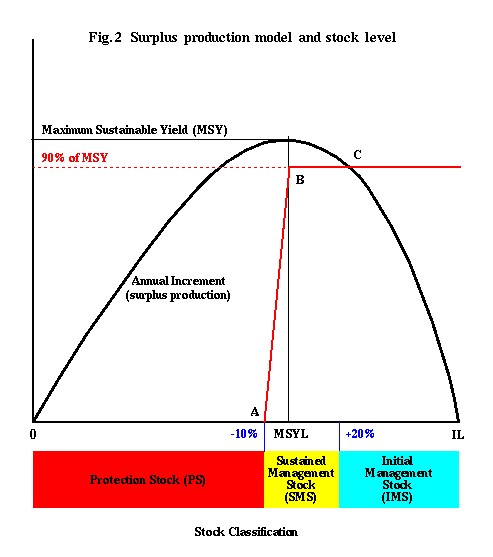
(from his article "Whaling and Conservation of Nature" presented in "Journal of Japanese Scientists", Vol. 19 No. 6, 1984)
Shoichi Tanaka
Professor at the Ocean Research Institute, The University of Tokyo
Based on the surplus production model, the new procedure is so worked out that the maximum yield of the whale population (maximum sustainable yield: MSY) can be attained rapidly and maintained taking into account at the same time possible risks resulting from undetermined factors in estimation. Since whales tend to adjust their birth rate depending on population density, this surplus production model which specifies the relation between the number of mature individuals and the number of surplus whales yielded above the number of natural death (natural increment) works out well. If whaling is restricted at the level of surplus production, the population remains constant and stable.

In Fig. 2 the horizontal and vertical axes stand for the level of stock size and surplus production respectively. When stock size is unexploited and the carrying capacity of environment is full (IL in the figure), and when the population is zero (0 in the figure), there is zero surplus production. But between the two points there is a point where the surplus production reaches the maximum value. Surplus at this point is defined as MSY, and the level of stock status corresponding to MSY is defined as MSYL (maximum sustainable yield level).
According to this model, stock is classified with MSYL being a criterion, which means that when stock level exceeds MSYL by more than 20%, it is defined as initial management stock (IMS). The stock whose level falls below MSYL by more than 10% is defined as protection stock (PS). And the stock whose level falls between the two is defined as sustained management stock (SMS). Whenever the stock level exceeds MSYL, the catch limits are set to 90% of the MSY. The straight line BC parallel with the horizontal axis on the figure represents catch limits. When the stock level falls below MSYL, a point on the straight line AB on the figure corresponding to the level of the stock status shows the catch limit. When a stock level is equal to MSYL, catch limit is not MSY but 90% of MSY, because a margin of 10% is allowed for possible estimation errors. Assuming that estimation error can be avoided, surplus production is equal to catch limit at point C, and stock is stabilized at this point. When stock falls below MSYL, catch limits are severely restricted, and a large portion of surplus production is utilized to facilitate recovery of the stock. It would not be necessary to impose such a severe restriction in cases where catch limits fall below surplus production, as stocks are expected to show steady recovery. Here again, taking into account estimation errors, safest precaution is taken.
When we put the new management procedure into practice, the values of MSYL, MSY, and also the present population level (PL) would have to be estimated. Estimation of these values is not always easy, because to estimate MSYL, various parameter values such as pregnancy rate under various stock conditions must be obtained. Since this is practically impossible, MSYL is determined on the basis of the initial level of the stock before the start of exploitation (IL), which is easy to estimate. According to the logistic curve generally applied to biological increment models, MSYL corresponds to 0.5IL. But as it is known that MSYL of many large mammals corresponds approximately to 0.6IL, the value 0.6IL has been adopted for baleen whales. The value of MSY is calculated from MSYL and from parameter values such as pregnancy rate. There also is the procedure where parameter values are estimated from the data of other species whose characteristics are already known in detail. When MSYL is set at 0.6IL, the level of protection stock should be 0.54IL, because it corresponds to 90% of MSYL.
Since the new management procedure was put into practice, many stocks have been estimated at less that 54% of the initial level and classified as protection stocks. In the Antarctic Ocean, fin whales and sei whales were estimated by each area of the sea. In 1975, catching of fin whales was banned in the areas from II to VI, and the catching of sei whales in area III. By 1978, all the fin and sei whales in the rest of the areas were classified as protection stocks and the catching of the two species was banned completely. Hunting sperm whales and minke whales had been allowed till 1979 when pelagic operation for whales other than minke whales was prohibited completely. Presently, only the catching of minke whales is allowed in the Antarctic.
In applying the new management procedure to minke whales in the Antarctic a problem arose in its application. By various evidences the stock is believed to have increased considerably till around 1970 when the harvesting of the stock started. If the stock had increased with no whaling, then the stock level in 1970 cannot be regarded as IL. Thus, it is impossible to determine its MSYL and calculate catch limits. In cases where catch limits cannot be set on account of insufficient scientific data, the catch quota is usually set at 0. But in the case of the Antarctic minke whale, it is unreasonable to set catch quota of zero for it is an increasing stock. Catching of minke whales are allowed within the bounds of surplus production, with MSYL being left undecided for the time being.
_